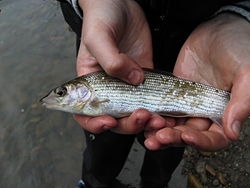Facts on Grayling
posted on 16 January 2015 | posted in Hints and Tips
Common name: Grayling
Latin name: Thymallus thymallus
Record weight: Despite a record weight of only 4lb 3oz, caught in 1989 by MrS.R. Lanigan, the grayling is known to grow much larger than this in Europe.Fish of almost ten pounds are possible in some rivers in Northern Europe!
Distribution: Found in the more mountainous areas across Europe where itthrives in small fast flowing streams with high water quality and cool water.Absent from Northern Scotland and Ireland. 
Features: The unmistakable huge dorsal fin of the grayling sets it apart fromall other salmonid species. The sail-like dorsal is almost as high as the depthof the fish and extends for one third of the fish's length. Like all salmonidsthe grayling has a small adipose fin behind the dorsal fin. The grayling has aslightly underslung mouth and steely blue/purple colouration
Diet: Grayling adore caddis larvae and eat them in very large quantities.Despite their underslung mouths, they are quite capable of feeding upondrifting prey, which they tip up to capture. As with most fish found in smallstreams, grayling mainly feed at dawn and dusk. Large grayling are known tofeed upon small fish, and in Scandinavian countries spinning with tiny lures isa recognised method for catching these sporting fish.
Spawning: Grayling spawn around the beginning of March in the UK, although inNorthern areas this may be delayed by as much as two months. Like allsalmonids, grayling spawn on clean gravel, excavating a small redd in thegravel in which their eggs are laid. Clean gravel with a good exchange of wateris essential for the survival of grayling eggs as they are very susceptible topollution. Adult grayling are not particularly fecund and only produce around10,00 eggs.
Growth: Grayling spend their first month of life within the gravel, first usingup the food reserves in their yolk sack, and then actively hunting smallinvertebrates that live between the particles of gravel. Once they emerge fromthe gravel, grayling grow extremely rapidly, reaching a length of around fourinches by the end of their first year. The young fish mature within three yearsat a length of around eight inches. Grayling are not a long-lived fish andrarely live for more than eight to ten years. In very rich streams, where theygrow more rapidly, they may only live for four to five years.
|




